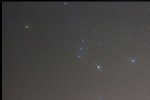So last night I set the camera up to try and catch some Geminid meteors, unfortunately I didn't get any on camera although I did see a couple. The 50mm lens is not really wide enough so you have to get lucky, I thought I would point towards Orion as that is slightly off the radiant and some meteors may shoot off in that direction.
Any way I digress... thought some may be interested in seeing what I got and a rough explanation of how I did it.
To start with this is a single shot 30 second exposure with an iso of 400 and aperture closed a touch to 3.5 ....

Now that is coolish, sort of but not really. You can still faintly see the blooming of M42 the Orion nebula but there is nothing extraordinary here.
What you do need is more data, now I could of changed my settings for a longer shot but the light pollution has a shitty effect on night photos.
For example take this pic, I used the same ISO but the aperture was fully open at 1.8 and well you can see how much more orange the sky is and even a glare streak from a street light.

The settings in the first pic are better.
So what comes next?
Well I set the camera on autoshoot and when inside and played Battlefront for a bit.
140 frames and just over 2 hours later I went back out and put the lens cap on and took another run of dark images which helps for noise reduction. I fell asleep at this point and brought the camera in in the morning.
Now I have a whole lot more data and thankfully a bunch of software exists to process it and get the most out of my images. So I load up all of my pics in a stacking program and about an hour later it churns out a stacked image for me to play with in photoshop. I make some initial tweaks in the stacking software, mainly aligning the RGB a bit and I get this.....

This is more interesting for sure but it can be improved somewhat, the gradient from the light pollution does not help matters and there is hidden detail in there so in photoshop I run a plugin to kill the gradient and I fiddle with the curves and levels and eventually it spits out this....

Muuuch better!
Not perfect by any means but from humble beginnings in the first pic to the final pic it is pretty cool from a light polluted back yard.
The meteor shower peaks tonight so weather permitting I'll give it another crack, not sure weather to gamble with Orion again for that one meteor streak which would make a cooler pic or to focus on Gemini or to turn tracking off altogether. I'll think of something.
































